Where to Start with Raymond Queneau
A literary treasure and seven categories introducing the works of an Oulipian master
This post is a companion piece to Barbara Wright’s “Reading Raymond Queneau,” a much more thoughtful, informative introduction to the Oulipian master’s life and works, which you should definitely read first.
My goal here isn’t necessarily to say anything really insightful about Queneau’s oeuvre, or break down the intricate mathematical patterns found in his works—I’m a huge fan, but definitely not any sort of Queneau Expert—but rather to provide any Queneau Curious people out there with a handful (well, handful plus two, I suppose) of places to start, based on what type of books appeal to you. Because, even though there is a sort of prototypical Queneau voice, a playful approach to literature that runs through all his works, there’s still a good deal of range among his books.
Which is something I think has gotten lost over the past couple decades. I could be wrong about this, but my sense is that he’s not nearly as read as he was back in the 1990s and early 2000s, and when he is, it’s exclusively within the frame of the Oulipo, using his more obviously constraint-driven works (Exercises, A Hundred Thousand Billion Poems) as historical examples of the movement’s core tenets about literary creation, while shooting right past all the incredibly fun, immensely rewarding novels that require a bit more work to identify the Oulipian elements.
I also think it’s worth spending some time with Queneau because, while reading a couple titles for this piece, I’m reminded of what a fundamental author he is in terms of a lot of the French literature I’m most drawn to. His spirit hovers over a lot of the authors I have lined up—Montalbetti, Toussaint, Salvayre, Echenoz, Chevillard, etc.—especially in how, similar to the works of Louis-Ferdinand Céline, he opened a pathway to writing in non-standard French, and in a way that doesn’t take the art of writing so deadly seriously. (Which is maybe an unfair criticism leveled against French art and writing as a whole, but it does have the reputation of being self-serious and stuffy—two things that Queneau definitely is not.)
To try and draw you into the wonderful world of Queneau, I’ve invented seven different “starting points” for a range of Queneau’s works. I’m not including everything that’s been translated, and don’t give a ton of detail or analysis on all of thiese, but hopefully something from here will appeal to you. I’m a firm believer that with an author like Queneau, once you start reading him, it’s very hard to stop . . .
But first, a bit of literary ephemera!

I teased this way back in the first French-literature related post, but this is one of my favorite personal literary objects:
“Tolling Elves 5,” is an incredibly modest pamphlet (or pamphlette? pamphletini? mini-lette?) featuring very, very brief excerpts from three of Queneau’s works—Zazie (in the Metro), Pierrot Mon Ami, and The Flight of Icarus—alongside some amazing cover illustrations.
In the world of literary collectibles, this probably isn’t all that special, although I can’t imagine there are all that many out there in the world (pretty amazing it survived multiple office moves), and probably none featuring a handwritten note from Barbara Wright . . .
One last prefatory note: For anyone who didn’t read Barbara’s piece, or just wants a quick refresher, Raymond Queneau was born in 1903, died in 1976, was an editor at Gallimard, a translator, and, briefly, a member of the Surrealists. He wasn’t into the automatic writing of it all though, so he broke away, and along with François Le Lionnais, is credited with founding the Oulipo, a writing movement that includes George Perec, Italo Calvino, Jacques Roubaud, Harry Mathews, Daniel Levin Becker, and many others, and which uses various constraints in their writing.1 He had a love of mathematics, which you can find in his works—as well as in many Oulipian constraints—along with his interest in philosophy, which he effortlessly incorporates into his books, and a very sharp awareness of how novels can be constructed.
He also wrote an absolute ton, so now, at last, here are some starting points for the uninitiated, or anyone looking to read more!
The Explicitly Oulipian Experiment
Arguably Queneau’s most popular book, Exercises in Style was originally translated by Barbara Wright and consisted of 99 short pieces each telling the same very short story about a bus ride, a confrontation, a button for an overcoat, in a different mode of writing: “Official Letter,” “Reported Speech,” “Ononmatopoeia,” “Awkward,” “Permutations by groups of 2, 3, 4, and 5 letters” (and groups of “5, 6, 7, and 8,” “9, 10, 11, and 12,” and “1, 2, 3, and 4”), and “For ze Frrensh,” for example. As such, this is an excellent book to use in writing and translation classes, or to pick up if you just want to enjoy seeing how he and his translators pulled off these various “exercises.”
The edition New Directions published to celebrate the book’s 65th anniversary is definitely the one to get. In addition to Barbara’s 99 pieces, there are two dozen additional exercises translated by legit Queneau scholar Chris Clarke, along with “Exercises in Homage to Raymond Queneau” written by Jesse Ball, Blake Butler, Amelia Gray, Shane Jones, Jonathan Lethem, Ben Marcus, Harry Mathews, Lynne Tillman, Frederic Tuten, and Enrique Vila-Matas.
Famously, Barbara Wright’s translation veers away from what is typically considered to be “translation,” at least in a conventional, conservative sense. Here’s David Bellos from Barbara Wright: Translation as Art:
Exercices 29, 30, 31 and 32 are retellings of the story in the main French tenses in which a story can be told: passé indéfini, présent, prétérit, and imparfait. As the distinction between preterite and imperfect is barely grammaticalized in English, Barbara decided to replace this set with her own variations on English story-telling verb forms: past, present, reported speech, and passive. The last two are therefore in effect Barbara’s own variations, and do not correspond directly to anything Queneau invented (though he could have, of course: there are many more exercises than the 99 in the book, but on that, more later). [. . .]
The most famous and spectacular of Barbara’s reinventions are exercises 83, 84, and 96, where she replaced, respectively, Queneau’s Italianismes with “Opera English,” his homophonic translation Pour Lay Zanglay with “For Ze Frrench,” and Queneau’s Paysan with “West Indian.” These are real “Exercises in Translation,” as the whole original manuscript is called: Barbara sought and found a target language functionally equivalent to the object-language of the original exercise, and trained herself to write in that register, dialect, or discourse, depending on the jargon you want to use.
His Personal Favorites
According to the afterword in The Blue Flowers (translated by Barbara Wright), Queneau was asked which books of his were his favorites and replied: “The Blue Flowers or The Sunday of Life. I don’t really know why.”
And here’s how Queneau described The Blue Flowers:
In The Blue Flowers, I focus on a person who goes back in time—and one who merges from some past era. In other words, modern and ancient. My historical character lived in the thirteenth century and reappears every one hundred and seventy-five years until he meets the other protagonist and becomes his contemporary. There is an old Chinese saying in this connection: “I dream that I am a butterfly and pray there is a butterfly dreaming he is me.” The same can be said of the characters in my novel—those who live in the pst dream of those who live in the modern era—and those who live in the modern era dream of those who live in the past.
So, in this novel, whenever the Duke of Auge (whose story starts in 1264) falls asleep, he dreams of Cidrolin, who lives aboard a constantly moored barge in 1964. And when Cidrolin naps (which happens a lot, generally after consuming a number of shots of essence of fennel), he dreams of Auge. Each character has their own concerns—Cidrolin, recently released from jail, is being pestered by someone painting mean graffiti on the fence by his barge, Auge doesn’t want to participate in any more crusades, and generally causes political and religious unrest, such as by creating the cave paintings of Lascaux to prove the existence of men before Adam—yet start incorporating ideas from each other into their lives via their respective “dreams.”
As Vivian Kogan points out in her afterword,
The Blue Flowers invites us to read it as a model novel. By model I do not just mean that it is worthy of imitation or that it is representative of the genre, but that it makes us think about how novels are composed and how they work.
I don’t want to overload this already gigantic post with more quotes, but I do think this passage from Kogan’s afterword helps to introduce the philosophical-structural element found in all of Queneau’s writing:
But the stories of Auge and Cidrolin can also be interpreted according to other systems of oppositions: the conscious and the unconscious, or time and space, for example. Auge, although a fictional character, appears in the context of Queneau’s narrative of “historical” moments. Situated in the past, Auge dreams of the future even as he reappears every one hundred and seventy-five years. Auge does not evolve in the seven hundred years of his odyssey, but his historical situation and his language do. In that sense, Auge can be seen to represent time. The Cidrolin narrative, on the other hand, emphasizes his place of residence, a stationary barge called L’Arche. Indications of distance and direction, points of departure and destination evoke spatial associations with the Cidrolin narrative line. This is reinforced by the absence of temporal progression. Time is even reversed as Cidrolin’s situation stagnates.
If all this—the formal experiments, the way his novels require an active reader—sounds a bit cerebral, don’t worry, Queneau is, hands down, one of the funniest writers of his time. There are simple jokes, loads of puns, wordplay that comes alive only when spoken aloud, and even some more vulgar bits.
After a fun discussion about how the news is just history in the present moment (if you watch enough news and live long enough, there’s no need to study history!), his daughters and sons-in-law try to convince Cidrolin to get a TV for his youngest daughter, Lamélie, who lives with him on the barge.
“I haven’t got the telly.”
“We know, we know,” says Bertrande, “considering that we’re telling Lamélie that you ought to get her one so’s she shouldn’t get so bored.”
“Yes, but,” says Cidrolin, “seeing that all she thinks about is fucking.”
“They don’t fuck very much,” says Lucet, “on the telly.”
“They even don’t fuck at all,” says Yoland.
“Stupids,” says Bertrande, “that’s because there’s kids watching.”
The Sunday of Life (1951, English translation by Barbara Wright, 1977) is considered one of Queneau’s wackiest, most free-wheeling novels, and was made into a film starring Danielle Derrieux.
From New Directions:
As always with Queneau, beneath the apparent absurdities of plot and the bumbling of his rather ordinary characters, there is a precision of structure and purpose that, ironically enough, places the work of this earliest of new-wave novelists squarely in the tradition of the eighteenth-century roman philosophique. In the ingenuous ex-Private Valentin Brû, the central figure in The Sunday of Life, Queneau has created that oddity in modern fiction, the Hegelian naïf. Highly self-conscious yet reasonably satisfied with his lot, imbued with the good humor inherent in the naturally wise, Valentin meets the painful nonsense of life’s adventures with a slightly bewildered detachment.
The humor, the general positivity, the very calculated structure . . . it makes complete sense, to me at least, as to why these two books were Queneau’s favorites.
The Big Three
Unlike many authors, it’s really hard to say, definitively, which Queneau novel is “The One.” The One that defines his legacy. The One that everyone must read to “know” Queneau. The One that will still be in print and discussed in 2125.
But the novel that comes closest to fitting that bill is Zazie in the Metro, one of his later novels (1951), but one of the first to appear in English when it came out in Barbara Wright’s translation (her first translation of one of his novels) in 1960.
Zazie is, on its surface, about a young girl’s manic, hilarous escapades in Paris over a weekend she spends with her uncle during a Métro strike. It’s funny, it’s tricksy in terms of plot and revelations, and it caused a bit of a stir for using dirty language.
In fact, the first edition of this book I bought was an old used mass market, and the only reason I bought it—I didn’t know who Queneau was at that time—was because this was scrawled on the inside cover: “I don’t see why such language must be used in a book. It destroys the good in it. If authors can’t write books without all this unenjoyable language, then they shouldn’t write at all,” with “oh, shut up!” added below by a different reader.
Zazie clicked for a lot of people, and it is one of Queneau’s most concentrated, precise novels. It was also made into a movie by Louis Malle, which definitely contributed to it becoming the only book of Queneau’s that was published as a Penguin Classic.
The Bark Tree, which was reissued in 2003 by NYRB as Witch Grass, is Queneau’s first novel and, according to some, the perfect representation of his literary method, combining quirky characters, exuberant wordplay, and seemingly random events, with an underlying mathematical model that weaves it all together.
As Barbara Wright quoted in her piece on “Reading Raymond Queneau,” he had this to say about his debut:
I have always thought that a literary work should have a structure and a form, and in the first novel I wrote I took great pains to see that the structure was extremely strict, and furthermore, that it was a multiple structure. . . . Since at the time I was, let’s say, rather arithmomaniac, I built this construction on combinations of numbers, some more or less arbitrary, others according ot my personal preferences.
If you’re someone (like me) who prefers to begin at the beginning, Witch Grass is a great introduction, and very likely to suck you into the Queneau-verse.
Pierrot Mon Ami was one of the first Dalkey Archive Essentials and has been one of his most beloved and acclaimed novels ever since its appearance in 1942. It was originally translated into English by Julian Maclaren-Ross in 1950, and although I’ve never seen that translation, I’m 100% certain that Barbara Wright’s retranslation for Dalkey in 1987 is far, far superior.
Chris Clarke (referenced both above and below) talked to my class about his Queneau translations a couple years ago, and brought up the point about how hard it would’ve been to translate Queneau in the moment as his works were coming out in French, in the period before critics and readers had really caught on to what he—and the Oulipo in general—were up to.
For example, there’s the famous case of Perec’s La Disparition (A Void) getting a poor review when it came out by a critic who hadn’t noticed that the entire book was written without an “e.” Which, sure, I get it, but also, this is more or less the core mystery the book’s plot revolves around: Anton Vowl goes missing and his friends have to decipher various linguistic games to find what is missing but cannot be named.
Obviously, translators are much closer to the text that most readers, but nevertheless, although I know that all the early translators had their hearts in the right place, they didn’t always cotton on to the linguistic games that Queneau was playing. Or at least not all the layers upon layers of reference and joke that are hallmarks of his wriring.
Anyway, Pierrot Mon Ami is a coming-of-age story involving a carnival that is uproariously funny and, again, seems totally disjointed, with a plot that leaps about, yet it comes together in a way that leaves the reader sensing the outline of some mathematical structure dictating the shape of the book as a whole.
Three Other Pre-WWII Books
I don’t know that it’s necessarily fair to say these are more “realistic,” but at least two of the three novels he published between 1936–38 (The Last Days, Odile, and Children of Clay) could be categorized as being more grounded and accessible than some of his later books.
Odile (translated by Carol Sanders) is a semi-autobiographical novel about a man who, having returned from war, gets temporarily involved with a artistic group of bohemians reminiscent of the Surrealists. A lot of Queneau’s criticisms of the Surrealists are represented in this slim novel, which, if I’m being honest, is pretty vague in my memory (read this in 1999 before starting at Dalkey), although I do remember it mostly for one particular John O’Brien anecdote.
At some point in time, John was talking to me about why a publisher decides to publish particular books. It can be for any number of reasons, rational or not, financial or not, personal or not, and he cited Odile’s opening paragraph as all the evidence he needed to want to publish this book. That’s all it took; after reading the opening paragraph he was convinced that whatever was to come was good enough to be on Dalkey’s list.
Here’s that paragraph:
As this story begins, I am on the road between Bou Jeloud and Bab Fetouh which skirts the walls of the town. It’s been raining. The last of the clouds are reflected in puddles of water. The slime oozes under my boots. I am dirty and shabby, a soldier returning from four months with an expeditionary force. Ahead of me motionless, gazing at land and sky, is an Arab. He has the noble air of a poet, or a philosopher. That’s how this story begins. There is, however, a prologue, and even though I can’t remember my childhood, my memory being as if ravaged by some disaster, there nevertheless remains a series of images from the time before my birth. Later on, people said that I couldn’t have been born like that, at twenty-one years of age, with my feet in the mud, surrounded by puddles, and, up above, the last stragglers of a beaten battalion of clouds, yet that is how it is: of my first twenty years, only ruins are left in a memory devastated by unhappiness.
It is a killer paragraph . . . (And also makes me want to reread Henry Green’s Back.)
The Last Days (translated by Barbara Wright) is also semi-autobiographical about student life in Paris in the 1920s, whereas Children of Clay (translated by Madeleine Velguth) moves away from autobiography with a conceit that’s more in line with what Queneau went on to write. From the New York Times review:
After he broke with Andre Breton and the Surrealists in 1929, Raymond Queneau spent three years doing research on some of France’s most interesting nineteenth-century eccentrics—people who claimed that the sun was made of ice, that they had squared the circle and so on. Unable to find a publisher, he spent the next few years weaving his discoveries into a novel, Les Enfants du Limon, which came out in 1938 and is now [1998] appearing for the first time in English. Children of Clay is the story of a dysfunctional family of industrialists, a thin narrative matrix into which the author has inserted his vast catalogue of real-life lunatics.
The Sally Mara Books
We Always Treat Women Too Well (translated by Barbara Wright) and Sally Mara’s Intimate Diary (translated by James Patrick Gosling)—both supposedly written by “Sally Mara”—are strange cases within Queneau’s oeuvre.
Sally Mara’s Intimate Diary was the second of these books to be released, although in terms of Sally Mara’s invented chronology, it comes before We Always Treat Women Too Well. It is, as the title indicates, an intimate diary from Sally Mara, a young Irish girl learning French from a tutor she has a crush on, but who has just left Ireland. In honor of him, she writes her diary in French, but since she’s not actually fluent in French, it’s a really mucked up version of the language filled with malapropisms and misusages—a 4-D chess level of wordplay that took James Patrick Gosling years to wrestle into English.
Here’s a bit from the opening of the book that gets at some of the game that Queneau is playing. All you need to know is that Monsieur Michel Presle, the French tutor Sally is crushing on, has just left by boat:
He taught me French. With determination! He taught it to me not too badly, so that, in his honor, as a souvenir of his leaving I mean to say, I am going to, from today, from now on, write my diary in his mother tongue. These will be my French writings. And the others, my diaries in English, I am going to fuck them into the fire.
“Fuck,” he told me, “is one of the most beautiful words in the French language.” It means: to throw, but with extra vigorosity. I repeat here his teachings, and what titillating pleasure it is to repeat them, a soft warmth filling my thoracic cavity from my shoulder blades to my young chest, which is not like a blade (i.e. flat), so for example: “you throw a glass of beer behind the necktie,” but “a diamond dazzles by fucking light into your eyes.” He, Monsieur Presle, greatly loved helping me understand the subtleties of the French language, and it is for that reason that now, in his memory, and one day to fuck over his idea of me, I will continue to write my diary in his native idiom.
This Sally Mara—who is constantly hit on in pretty gross ways by an assortment of creeps—grows up to write We Always Treat Women Too Well, a novel taking place during the 1916 Easter Rebellion, centered around Gertie Girdle, who gets trapped in a post office seized by Irish rebels. And, emphasizing Queneau’s more metafictional games, Monsieur Presle supposedly translated this novel from Gaelic into French.
Given the content of these novels, the Irish setting, the use of a pseudonym—these two novels tend to be overlooked. But Jordan Stump—one of the best translators from the French of all time—has a really interesting read on “Sally Mara’s Complete Works” in his book on Queneau, Naming & Unnaming: On Raymond Queneau, that teases out some of the levels of play in this side-project of Queneau’s:
The novel’s cover bears two names, Sally Mara and Raymond Queneau, both occupying a place reserved for the author; the reader’s first impulse, of course, is to dismiss this small conundrum as a simple literary conceit, that of the text written by an unknown individual, then “discovered” and published by another (in the manner of Lolita, for instance). But from the first sentence, Sally’s preface demolishes that comfortable certainty: “It is not often that a supposedly imaginary author has a chance to preface his or her complete works, especially when they appear under the name of a so-called real author.” With this, both names are called into question; we no longer know “which signature to trust.” Wishing to prove herself the true author, Sally assures us that the supposedly imaginary author of this
novel “is in fact in no way imaginary, since it is I, the signatory of the present preface, and any claim to a higher reality is thus refuted a priori, sine die, ipso facto and manu militari.” [. . .] To the reader, in fact, both Sally Mara and Raymond Queneau are only names on a piece of paper; which of the two are we to accept as real?This question is complicated by Sally’s insistence on casting doubt on her own reality even as she denies any claim to a more real reality on the part of the usurper. She rejects out of hand the biographical sketch drawn up by Michel Presle for the preface of We Always Treat Women Too Well: “I was born Easter Monday 1916, the day of the Irish uprising? Nothing could be further from the truth: I was never born.” Our first impression is that she is seeking to define herself here as a purely literary character, for whom such notions as birth do not apply. But she goes on: “I died unknown in Cork in 1943? Nothing could be more false: I am writing this preface eighteen years later and I have none of the qualities of a ghost, except the corpulence.” If she was never born but is still alive (and is not a ghost, although it might be worth noting here that Queneau originally thought of entitling her preface ‘‘Reflections of a Ghost’’), then what is she?
The More Metafictional
If you’re interested in hearing more about the Sally Mara books, you should check out the podcast below, in which Chris Clarke and Daniel Levin Becker joined me to talk about Queneau, with a special focus on Sally Mara’s Intimate Diary, Pierrot Mon Ami, and Chris’s retranslation of The Skin of Dreams.
Although most of Queneau’s novels contain some sort of self-aware, metafictional nod, The Skin of Dreams and The Flight of Icarus are, in my opinion, in a separate category.
The Skin of Dreams is like “The Secret Life of Walter Mitty” meets Stardust Memories. It’s also akin to The Blue Flowers in the way both are about dreams, although this time its of the waking, fantastic variety. Skin of Dreams is an incredibly fun book to read, and if you compare Chris’s translation against the previous one by H. J. Kaplan, you can learn a lot about the craft and creativity of translation.
The Flight of Icarus is a cross between Six Characters in Search of an Author and Mulligan Stew. It’s a novel about an author who is working on a new novel, but loses his character after only 10 pages when Icarus flees his book and goes missing. This leads Hubert to hire a detective to find his protagonist, working under the assumption that Icarus has been character-napped by one of Hubert’s fellow “writers.” Such as Jacques, whose new novel “isn’t about anything” except in so far as he “wanted to give the impression of the color mauve.” (Soooo French!)
Written like a play, The Flight of Icarus is a quick burst of Queneau turned up to 13. Everything is amped, from the metafictional games that call Flann O’Brien’s At Swim-Two-Birds to mind, to the jokes, the breakneck speed of the plot, the verbal wordplay. There are a couple really great examples of how Queneau & Wright created jokes that really only work when spoken aloud. This is common throughout his works, and is yet another element that makes reading Queneau such a joyful experience. Here’s a bit from when Icarus goes out to eat alone, since his lover, LN, has left him alone for a few weeks.
WAITER. And how is Mademoiselle LN?
ICARUS. LU-sive.
Another example of this is the way the detective Morcol mishears Hubert’s description of his missing character, and spends the first third of the book searching for “Dicky Ruscombe.”
HUBERT. My Dicky? Why do you call him Dicky?
MORCOL. I call him Dicky because you call him Dicky.
HUBERT. I don’t call him Dicky, I call him Icarus.
MORCOL. First I’ve heard of it. Didn’t you say: I shan’t be able to work until the mystery’s solved and Dicky Ruscombe’s back? Ruscombe was his surname, I presumed.
HUBERT. His name is Icarus, and that’s that.
To get “icaruscomesback” into “Dicky Ruscombe” is pretty ingenious.
Some of the Rest
Obviously, the groupings above don’t include all of Queneau’s books currently available in English. There’s at least one other novel (Saint Glinglin, translated by James Sallis) and a lot of poetry. There’s Chên et chien (translated by Madeleine Velguth), which is from 1937 and is Queneau’s first book of poetry. There’s also Rachel Galvin’s translation of Hitting the Streets (Courir les rues, 1967) from his later period, and EyeSeas: Selected Poems, a collection translated by Daniela Hurezanu and Stephen Kessler and spanning his whole career.
There’s also Stories & Remarks (translated by Marc Lowenthal), which is a collection of all sorts of stuff: stories, a play, an unfinished novel, essays, etc. And Letters, Numbers, Forms: Essays, 1928–70 (translated by Jordan Stump) is exactly what its title is—a collection of Queneau’s essays on literature, poetry, writers, language, etc.
So much more can be—and has been—said about Queneau’s literary approach, his specific books, his overall genius. But hopefully, if this post accomplishes anything, it at least will add a couple titles to your “to read” list.
Some of which are very line- and word-based, such as a lipogram (omitting one or more letters from your work, such as the lack of an “e” in Perec’s A Void), N+7 (replace every noun in a text with whatever the seventh noun is after it in a dictionary), the prisoner’s constraint (in which no letters with stems or tails can be used, so instead every letter in a piece is the exact same height), or palindromes.
Others are more structural, or influential on that plot, such as “X takes Y for Z” (a staple of drawing room comedies, but which can become much more complex in the hands of a mathematically inclined writer), or Perec’s deployment of the “knight’s gambit” to determine the progression of the chapters in Life, a User’s Manual as he moves from square to square across a 10x10 Parisian apartment building, or Mathews’s Algorithm, which has never been spelled out, but is (allegedly) the underlying engine for how Cigarettes is put together (or, maybe, just a mythic algorithm).





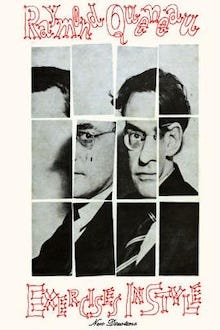
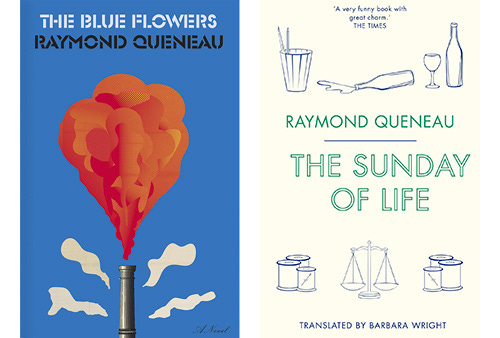

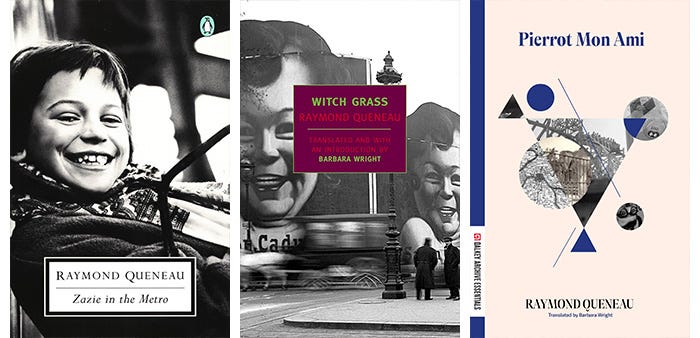
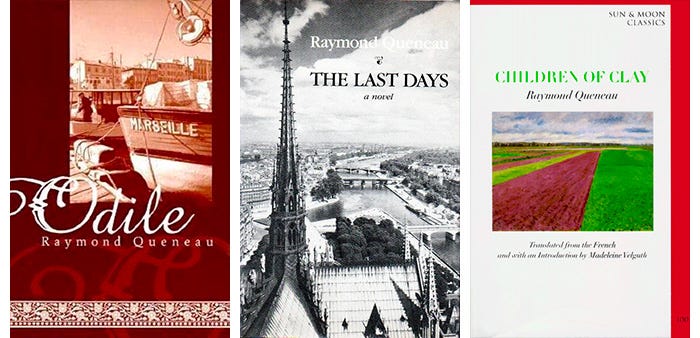
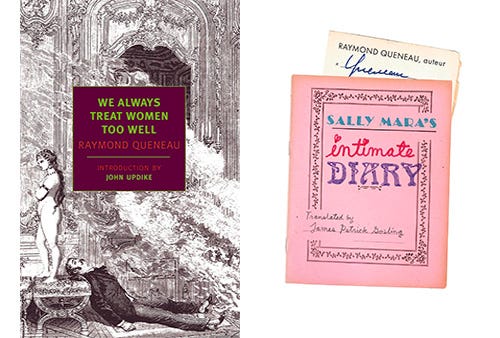
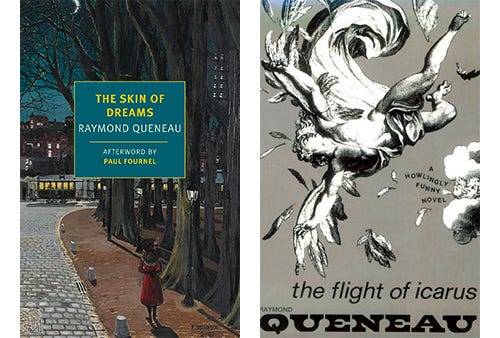
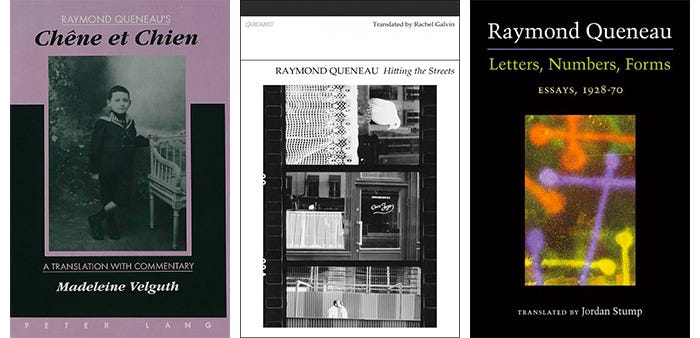
As someone who has a long interest in the Oulipo, and who must admit has read & enjoyed Queneau "exclusively within the frame of the Oulipo", specifically Queneau's "more obviously constraint-driven works (Exercises, A Hundred Thousand Billion Poems)", I really appreciated this guide to Queneau's other works! Thank you.
A major reason I have hesitated to dip into Queneau's other books is the issue of linguistic play: in particular Zazie in the Metro (his most famous novel apart from Exercises) always sounded too bound up in the specifics of French for a translation to be worth it. From your description, I might have the same fear of the Sally Mara books. One answer to this your piece suggests is to first read others—you make a number of them sound quite worthwhile and I will probably start there. Another answer is to trust the translators, which it sounds like you would agree with—referring to "a 4-D chess level of wordplay that took James Patrick Gosling years to wrestle into English" implies that Gosling succeeded! But if you could say more about this—whether, in the end, Queneau's more linguistically-bound books really do carry over in translation—I'd love to hear it.